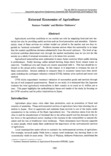External Economies of Agriculture
JIRCAS international symposium series
| ISSN | 13406108 |
|---|---|
| NII recode ID (NCID) | AA1100908X |

Full text
intlsymp-6_123-132.pdf278.06 KB
Agricultural activities contribute to our society not only by supplying food and raw materials but also by providing useful services such as flood prevention and amenities. Unfortunately, most of these services are neither traded nor priced in the market and are thus regarded as "external economies". Problems become serious when the externality is so large that the market equilibrium deviates substantially from the social optimum. The level of agricultural activities determined only through the market mechanism may be too low for the society as a whole if external economies are to be taken into account.
Agricultural externalities seem substantial in many Asian countries where paddy farming is predominant. Paddy farming, unlike upland farming, helps check flood, retains water as reservoir. Traditional arts and rituals are closely associated with it. This fact should be reflected in the actual policy making. In this respect, it is important to evaluate the size of these externalities. Several methods to measure them in monetary terms have been developed, including the contingent valuation method (CVM), hedonic price method and travel cost method.
CVM elicits respondents' monetary valuation of non-market goods and services through the use of well prepared questionnaires. Based on our study, it is estimated that the Japanese evaluate the total agricultural externalities in their country at as much as 4.1 trillion yen a year. This paper highlights the methodological issues and results of the study by, focusing on the CVM valuation and its policy implications in Japan.
Agricultural externalities seem substantial in many Asian countries where paddy farming is predominant. Paddy farming, unlike upland farming, helps check flood, retains water as reservoir. Traditional arts and rituals are closely associated with it. This fact should be reflected in the actual policy making. In this respect, it is important to evaluate the size of these externalities. Several methods to measure them in monetary terms have been developed, including the contingent valuation method (CVM), hedonic price method and travel cost method.
CVM elicits respondents' monetary valuation of non-market goods and services through the use of well prepared questionnaires. Based on our study, it is estimated that the Japanese evaluate the total agricultural externalities in their country at as much as 4.1 trillion yen a year. This paper highlights the methodological issues and results of the study by, focusing on the CVM valuation and its policy implications in Japan.
| Creator | Kentaro Yoshida Eiichiro Nishizawa |
|---|---|
| Publisher | Japan International Research Center for Agricultural Sciences |
| Available Online | |
| Issue | 6 |
| spage | 123 |
| epage | 132 |
| Language | eng |
